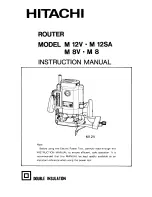
T5
-12-
Side-Fence Routing
The side-fence is used to guide the router when
moulding, edge profiling or rebating the edge of
the workpiece or when routing grooves and slots
in the centre of the workpiece, parallel to the
edge.
The edge of the workpiece must be straight and
true. The cheeks are adjustable and should be
set ideally with a 3–4mm gap each side of the
cutter.
Fitting and using the Side-Fence
I
Make sure the thumb knobs (3) are fully
released. Slide the guide rods (1) into the
routing base (2) and tighten the thumb knobs
(3).
I
Adjust the side-fence (4) to the required
distance and clamp in place with the thumb
knobs (5).
I
Then lower the cutter height until the cutter is
just above the workpiece.
I
Fine adjustments are possible by slackening
the thumb knobs (5), adjusting the micro-
adjustment knob (6) and securing it again with
the thumb knobs (5). One revolution of the
micro-adjustment knob (6) equals 1.25mm of
side-feed.
I
Lower the cutter onto the workpiece and set
the cutter height by raising the depth stop (7)
the required distance.
I
Switch on the router and when the cutter
reaches full speed, gently lower the cutter into
the workpiece and lock the plunge.
I
Feed along the timber, keeping sideways
pressure (A) to ensure the side-fence does
not wander away from the workpiece edge
and downward pressure on the inside hand
(B) to prevent the router from tipping.
I
When finished, raise the router, secure with
the plunge locking grip knob (8) and switch
off.
C
D
When starting the cut, keep
the pressure on the front
cheek (C) until the back
cheek contacts the
workpiece edge.
At the end of the cut, keep
pressure on the back cheek
(D) until the cut is finished.
This will prevent the router
cutter swinging in at the end
of the workpiece and
‘nipping’ the corner.
MANU/T5 v9.0 19/2/09 13:10 Page 12








































